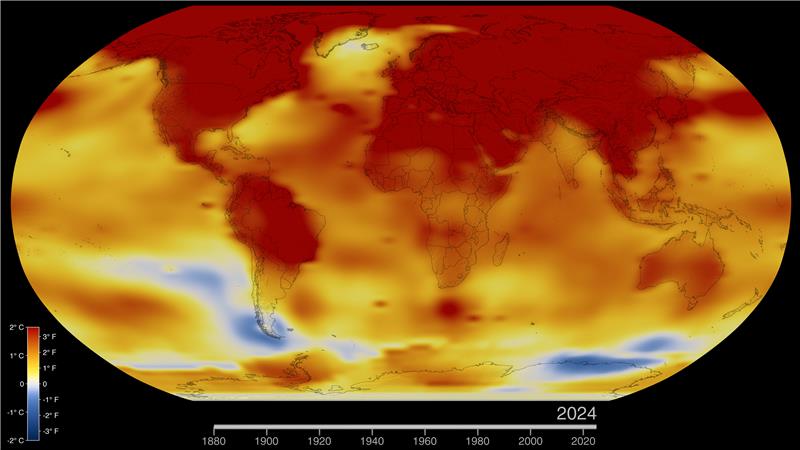Earth’s Record-Breaking Warmth in 2024: An In-Depth Analysis
In 2024, Earth’s surface temperature reached unprecedented levels, marking the warmest year since record-keeping began in 1880. This conclusion comes from a detailed analysis spearheaded by NASA scientists, who reported that global temperatures were 2.30 degrees Fahrenheit (1.28 degrees Celsius) higher than the agency’s 20th-century baseline, which spans from 1951 to 1980. This new record surpassed the previous high set in 2023 and was preceded by 15 consecutive months of record-breaking temperatures from June 2023 through August 2024 — a remarkable pattern of continuous warming.
NASA Administrator Bill Nelson emphasized the urgency of understanding our planet’s changing climate, especially in light of the record-breaking temperatures and the wildfires that posed a threat to both NASA’s operations and its workforce in California. The year 2024 was not only significant for its unprecedented heat but also because it was estimated to be approximately 2.65 degrees Fahrenheit (1.47 degrees Celsius) warmer than the mid-19th century average (1850-1900). This level of warming has surpassed previous records, with average temperatures exceeding 1.5 degrees Celsius above the baseline for much of the year, hinting that the annual average might have crossed this threshold for the first time.
Contextualizing the Paris Agreement
The Paris Agreement on climate change aims to limit global temperature rise to below 1.5 degrees Celsius over the long term. To provide context, during Earth’s warm periods around three million years ago, sea levels were significantly higher, and temperatures were only about 3 degrees Celsius above pre-industrial levels. Gavin Schmidt, the director of NASA’s Goddard Institute for Space Studies, pointed out that we are halfway to reaching these Pliocene-level temperatures in just 150 years.
Drivers of the Warming Trend
The warming trend observed over recent decades is primarily attributed to the accumulation of heat-trapping greenhouse gases such as carbon dioxide and methane. In 2022 and 2023, Earth experienced record increases in carbon dioxide emissions from fossil fuels. The concentration of carbon dioxide in the atmosphere has surged from pre-industrial levels of approximately 278 parts per million to about 420 parts per million today.
NASA, along with other federal agencies, conducts regular data collection on greenhouse gas concentrations and emissions. This information is consolidated in the U.S. Greenhouse Gas Center, which aims to provide decision-makers with accessible data and analysis by merging observations and models.
Exceptional Heat Trends
Natural climate phenomena such as El Niño and La Niña can influence the temperatures of individual years by alternately warming and cooling the tropical Pacific Ocean. The strong El Niño event that began in the fall of 2023 contributed to pushing global temperatures to record highs. The heat surge that started in 2023 persisted into 2024, even after El Niño subsided. Researchers are investigating other factors that may have contributed to this trend, including potential climate impacts from the January 2022 Tonga volcanic eruption and reductions in pollution that might alter cloud cover and the reflection of solar energy back into space.
Gavin Schmidt noted that while not every year will set new records, the long-term trend of increasing temperatures is evident. The impacts of this warming are already manifesting in extreme weather events such as heavy rainfall, heatwaves, and increased flood risks, which are expected to intensify as long as greenhouse gas emissions continue to rise.
Observing Local Changes
NASA compiles its temperature records using a vast array of data, including surface air temperature measurements from tens of thousands of meteorological stations and sea surface temperature data collected by ships and buoys. This data undergoes analysis to account for the varying distribution of temperature stations globally and potential urban heating effects that could skew the results.
A recent assessment by scientists from institutions such as the Colorado School of Mines, the National Science Foundation, NOAA, and NASA has bolstered confidence in NASA’s global and regional temperature data. Schmidt explained that climate changes initially appear in the global average, then at the continental and regional scales, and finally at the local level. The changes in everyday weather patterns have become increasingly apparent to people worldwide.
Independent analyses by NOAA, Berkeley Earth, the Hadley Centre (part of the UK’s weather forecasting Met Office), and Copernicus Climate Services in Europe have also verified that global surface temperatures in 2024 were the highest since the inception of modern record-keeping. Although these organizations use similar temperature data, they employ different methodologies and models, all of which consistently demonstrate an ongoing warming trend.
NASA provides its complete dataset of global surface temperatures and detailed information on how its scientists conducted the analysis through the Goddard Institute for Space Studies. This transparency allows the public and researchers to explore the data that underpins NASA’s findings.
For further information, you can visit NASA’s dedicated Earth page at NASA Earth. This page serves as a hub for updated information on Earth’s climate and NASA’s ongoing efforts to monitor and understand climate change.
In summary, 2024 stands as a stark reminder of the urgent need to address climate change. The record-breaking warmth, driven by human-induced greenhouse gas emissions, underscores the importance of international efforts to mitigate climate impacts and transition to sustainable energy sources. As scientists continue to study these trends, the data collected provides invaluable insights into the state of our planet and highlights the critical need for global collaboration to preserve the Earth’s climate for future generations.
For more Information, Refer to this article.


































